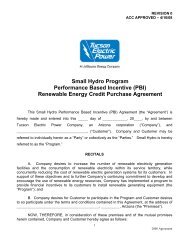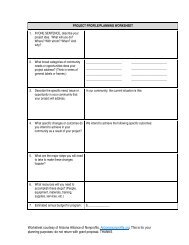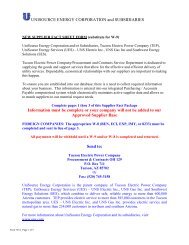Efficient Home Program Air Sealing Checklist - TEP.com
Efficient Home Program Air Sealing Checklist - TEP.com
Efficient Home Program Air Sealing Checklist - TEP.com
You also want an ePaper? Increase the reach of your titles
YUMPU automatically turns print PDFs into web optimized ePapers that Google loves.
<strong>Efficient</strong> <strong>Home</strong> <strong>Program</strong><br />
<strong>Air</strong> <strong>Sealing</strong> <strong>Checklist</strong><br />
Page 2 of 3 (rev. 3/13)<br />
Basement/Crawl Space<br />
Corrective Action Description<br />
1. Plumbing Penetrations Sealed: Gaps between plumbing penetrations and the conditioned area were sealed with 1 part<br />
foam. If the gap was greater than 1 inch, the opening was sealed with a rigid material such as extruded polystyrene (EPS) and<br />
the edges sealed with 1 part foam.<br />
2. Wiring Penetrations Sealed: Gaps around wiring penetrations that pass between the basement and the conditioned area<br />
were sealed with 1 part foam.<br />
3. Chimney Chases Sealed: If the heating or DHW system is located in the basement there may be a chimney or <strong>com</strong>bustion<br />
vent pipe that passes through the basement ceiling. This penetration was sealed with fire rated materials. A good choice is<br />
metal flashing to bridge any large gaps and fire rated caulk to seal the edges of the metal flashing. Non-fire rated materials are<br />
not allowed within 3 inches of the chimney or vent pipe.<br />
4. Mechanical Chases Sealed: Mechanical chases can be large openings between the basement and the living space to allow<br />
ducts, pipes and wire bunches to pass through. Fire rated materials are not required when sealing these openings. This<br />
penetration was sealed and if the gap around the mechanicals was larger than 1 inch, a rigid backing material was used and<br />
the edges were sealed with 1 part foam. The rigid backer does not have to be able to support the weight of insulation.<br />
5. Rim and Band Joist Sealed: The area where the floor joist sits on the exterior wall plates creates an area referred to as the rim<br />
and band joist. This area was sealed with either 1 part foam or caulk. The gap area that is formed by the floor joist sitting on the<br />
top plate, the floor sheathing sitting on the floor joist, and the connection of the floor joist to the rim joist were all sealed as<br />
<strong>com</strong>pletely as possible.<br />
6. Basement Access Sealed: The basement access, whether a hatch or a door, was weather stripped with q-lon with carrier.<br />
The rough framing around the opening was sealed with 1 part foam and the finish work sealed with caulk if the homeowner<br />
allowed.<br />
7. Ground Cover Installed and Sealed: If the basement floor is not a concrete slab and is also not a high use area, it was<br />
covered with a 6 mil polyethylene sheet. The seams of the sheet were overlapped at least six inches and sealed with glue,<br />
caulking or tape. If possible it was extended up the basement walls a foot and mechanically attached to the wall, and the<br />
seam between the wall and plastic sheet was also sealed.<br />
8. Windows Caulked or Foamed: If there are windows in the basement area, gaps between the window framing and the<br />
window or the framing and the foundation were sealed with caulk or 1 part foam.<br />
q N/A<br />
q Action Taken<br />
q N/A<br />
q Action Taken<br />
q N/A<br />
q Action Taken<br />
q N/A<br />
q Action Taken<br />
q N/A<br />
q Action Taken<br />
q N/A<br />
q Action Taken<br />
q N/A<br />
q Action Taken<br />
q N/A<br />
q Action Taken<br />
<strong>TEP</strong> <strong>Efficient</strong> <strong>Home</strong> <strong>Program</strong> I tep.<strong>com</strong>/Efficiency I email: <strong>TEP</strong>Apps@csgrp.<strong>com</strong>








